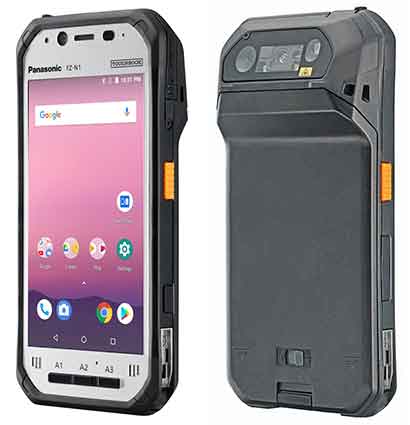|
Panasonic Toughbook FZ-N1
Panasonic updates its popular 4.7-inch handheld with much more powerful technology and the latest version of Android. And makes it tougher than ever.
(by Conrad H. Blickenstorfer)
On July 24, 2018, Panasonic announced an updated version of its fully-rugged Toughbook FZ-N1. The Android 8.1-based 4.7-inch handheld packs a faster processor, enhanced electronics, more memory and storage, and various refinements to meet the evolving needs of today's data-driven industries.

Despite its toughness, this is a light and handy device. With a footprint roughly that of an Apple iPhone 8 Plus, the upgraded FZ-N1 is a bit smaller than the company's similar and also Android-based 5-inch Toughpad FZ-X1.
Tough, light, and handy
While the displays are close in size, the Toughbook FZ-N1 is about a third lighter (9.8 ounces versus 15 ounces) than the super-rugged FZ-X1 model, and its main body is only a bit over half as thick (.64 inches vs. 1.2 inches). That's in part due to a different design approach. Whereas the FZ-X1 has a beefy 23.6 watt-hour battery and the scanner mounted on top, the FZ-N1 comes with a smaller 12.2 watt-hour standard battery and its barcode reader is at the backside of the device, angled so that that users can scan items without bending at the elbow or wrist while retaining full view of the display through the scanning process.
Even with the lighter, slimmer design, the FZ-N1 is much tougher than your typical consumer smartphone. Thanks to its fully-rugged construction it can survive drops from up to seven feet to concrete, as well as a thousand tumbles from one meter. It is also IP68 rated, which means it is totally dustproof and waterproof, including full immersion down to five feet for up to 30 minutes.
Android all the way
Since Microsoft bowed out of the handheld computer space, Panasonic (like everyone else) no longer offers both Windows Mobile and Android versions of its small platfroms. It's only Android now, and the Toughbook FZ-N1 comes with the as of this writing (July 2018) up-to-date version 8.1 "Oreo" of Android.
The question comes up where that leaves customers invested in Panasonic's older Microsoft-based handhelds. Panasonic addresses that with its MCL360 platform that facilitates migration of legacy applications so they can run natively on modern devices. MCL360 retains familiar interface designs, provides compatibility with existing systems and, in essence, allows continued use and support of tried-and-true software.
Android 8.1 "Oreo," which is used in the Toughpad FZ-N1, was initially introduced December 2017. As of July 2018, according to the Android Developers site, Android Oreo versions 8.0 and 8.1 are used in about 12% of all Android devices. Compared to earlier versions of Android, Oreo boots quicker, allows minimizing of background overhead, adds auto-fill and smart text selection, has picture-in-picture, streamlines the user interface, and much more. Like the competition, Panasonic commits to several version updates for the FZ-N1 platform.
State-of-the-art rugged tech
For specs of the updated FZ-N1, Panasonic switched from the 32-bit quad-core Qualcomm Snapdragon MSM8974AB processor in the original version to a newer and more powerful 64-bit octa-core Snapdragon SDM660 chip running up to 2.2GHz. Memory is up from 2GB to 3GB of faster LPDDR4 RAM. Mass storage has doubled to 32GB eMMC plus what's in the micro SDXC card slot on the storage side.
The daylight-viewable 1280 x 720 pixel 4.7-inch screen with anti-glare and anti-reflective treatment, brightness up to 500 nits, and 10-point capacitive multi-touch remains the same. It works with any type of glove, and there's a rain-sensing feature that allows for single-touch even in pouring rain. Optional passive pens and even active pens are available; the active one seems to be of the Wacom variety that doesn't need a battery, similar to what's used with the Toughpad FZ-M1.
There are 5mp (front) and 8mp (rear) cameras for communication and documentation. There are NFC and integrated SE4750 1D/2D barcode reading. 801.11ac and Bluetooth v5.0 make for speedy, contemporary WWLAN/WPAN connectivity, and there are dual nano-SIMs for 4G LTE, HSPA+, UMTS, EDGE, GPRS, GSM, CDMA 1x, EVDO Rev.A mobile broadband. Additionally, Panasonic P.180 is available for seamless global connectivity in over 180 countries via eSIM technology for Tier 1 LTE access. Since voice calls can be trying in noisy outdoor/work settings, the FZ-N1 has triple microphones and powerful dual front speakers that can generate up to a very loud 100 decibels in volume.
While most contemporary tablets have more than adequate battery life, many consumer smartphones don't. Panasonic wanted to make sure customers wouldn't have to worry about being stranded with a dead device. The FZ-N1 battery can handle full 8-hour shifts of continuous data operation (and up to 12 hours of scanning), offers warm-swapping of batteries, and then there's the optional extended battery that doubles battery capacity.
Better and tougher than ever
Worthy of its Toughbook name, the newly enhanced FZ-N1 is a prime example why Panasonic is already #3 in the hotly contested rugged handheld market.
The Toughbook FZ-N1 starts at US$1,899. That's not insubstantial. But for that, customers get a true Toughbook handheld with easy integration into existing IT infrastructures, industrial-grade scanning, guaranteed ongoing support, longer lifespan, and likely an overall lower total cost of ownership. All of this makes the upgraded Panasonic Toughbook FZ-N1 a compelling choice for a wide variety of shipping/receiving type of applications where strong performance, ruggedness, and manageable size and weight matter. Conrad H. Blickenstorfer, July 2018
|



